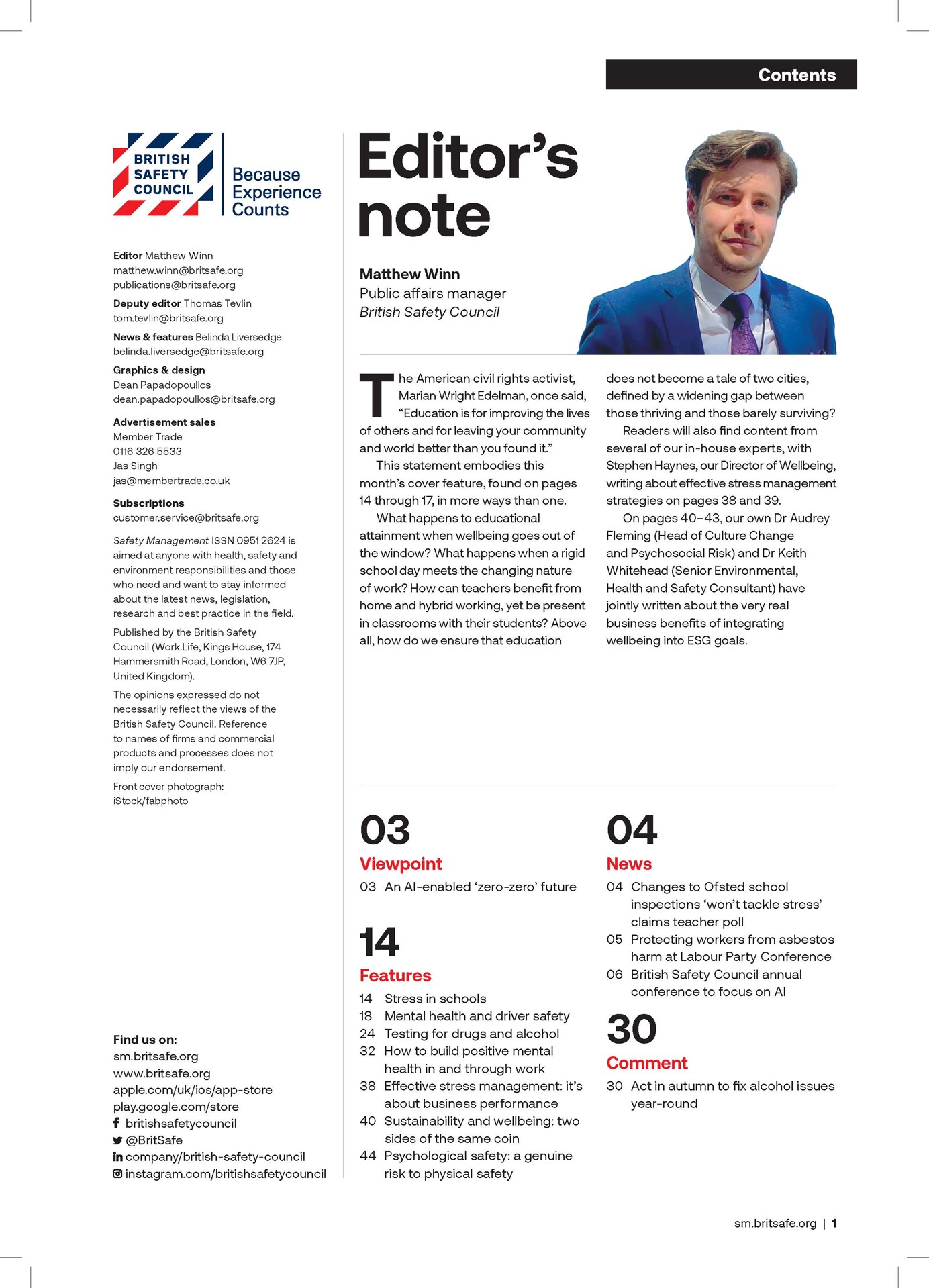Driving for work can be physically demanding and emotionally taxing, and the resulting psychological toll can greatly increase the risk of being involved in a collision. However, a new toolkit provides employers with a framework and guidance to embed effective mental health support for drivers into their organisational culture and operational strategy.
Features
Why mental health is central to driver safety
In the high-stakes world of fleet operations and driver risk management, safety professionals have long focused on vehicle roadworthiness, compliance and collision prevention. But a critical factor has often been overlooked: the mental health of the drivers themselves.
With World Mental Health Day falling this month on October 10th, the Driving for Better Business (DfBB) Driver Wellbeing Toolkit is a timely and essential resource that reframes driver safety through the lens of psychological health – offering practical guidance for employers and, specifically, safety, health and wellbeing professionals to support those who drive for work.
This article explores the key themes of the toolkit, why it matters, and how organisations can embed mental health into their safety culture.
 Drivers often work in isolation, face unpredictable conditions, and may be exposed to abuse or aggression on the road. Photograph: iStock
Drivers often work in isolation, face unpredictable conditions, and may be exposed to abuse or aggression on the road. Photograph: iStock
Mental health: the hidden risk behind the wheel
Driving is a safety-critical task that demands focus, emotional regulation and rapid decision-making. Yet, many drivers face personal and professional pressures that undermine these abilities. According to the Health and Safety Executive, over 776,000 UK workers suffer from work-related stress, depression, or anxiety – leading to 16.4 million lost working days annually. For those who drive for work, the risks are amplified.
Mental health challenges often go unnoticed in fleet environments, where performance is measured by delivery times and meeting performance targets or client SLA (Service Level Agreement) requirements. But beneath the surface, psychological strain can erode a driver’s ability to operate safely. The DfBB Driver Wellbeing Toolkit reframes mental health as a core safety issue – one that demands the same rigour and attention as mechanical faults or road hazards. It’s a call to action for professionals to recognise that wellbeing isn’t a soft issue – it’s a hard risk.
Poor mental health can impair:
- Reaction time and hazard perception
- Risk assessment and decision-making
- Emotional regulation and rational responses
- Sleep quality, leading to fatigue
- Compliance with safety protocols.
Scientific research shows that poor mental health nearly doubles the risk of a road traffic collision. In short, mental health is not just a wellbeing issue – it’s a safety imperative.
Why drivers are uniquely vulnerable
Drivers often work in isolation, face unpredictable conditions, and may be exposed to abuse or aggression on the road. Vocational drivers – especially van and truck drivers – are statistically more likely to suffer from mental health issues. The average age is 51, and most are male, a demographic less likely to seek help due to cultural and generational norms.
Unlike office-based staff, drivers rarely have access to immediate peer support or managerial oversight. Their work is physically demanding, emotionally taxing, and often underappreciated. Long hours, tight schedules, and poor roadside facilities compound the stress. The DfBB toolkit shines a light on this hidden workforce – revealing the psychological toll of driving for work and urging employers to rethink how they support those behind the wheel. It’s not just about duty of care – it’s about dignity, safety and staff retention.
The toolkit reveals some sobering statistics:
- Van drivers have a 25 per cent higher suicide rate than the national average
- Truck drivers have a 20 per cent higher suicide rate than the national average
- 93 per cent of HGV drivers say work-related stress negatively affects driving performance
- 47 per cent of HGV drivers have considered quitting due to stress.
These figures underscore the urgent need for proactive mental health management in fleet operations.
 Graph: Driving for Better Business
Graph: Driving for Better Business
Employer responsibilities: legal and ethical imperatives
Under the Health and Safety at Work Act 1974, employers have a duty of care to ensure the safety, health and wellbeing of employees – including those driving for work. This includes preventing work-related stress, identifying and supporting drivers with personal issues that affect driving, creating psychologically safe environments, and ensuring managers are trained to spot and respond to mental health concerns.
But legal compliance is only the baseline. Ethical leadership demands that employers go further – embedding mental health into their organisational culture and operational strategy. The DfBB toolkit helps translate broad legal obligations into sector-specific actions, offering a bridge between policy and practice. It encourages organisations to view mental health not as a reactive HR issue, but as a proactive safety priority. For health and safety professionals, this means integrating wellbeing into risk assessments, driver briefings and performance reviews.
This includes:
- Preventing work-related stress
- Identifying and supporting drivers with personal issues that affect driving
- Creating psychologically safe environments
- Ensuring managers are trained to spot and respond to mental health concerns.
The 2017 Thriving at Work review by Stephenson and Farmer outlines six core standards for employers, including having a mental health plan, educating staff and making regular wellbeing checks. The DfBB toolkit aligns with these standards and translates them into actionable steps for fleet operators.
 Stress triggers the body’s fight, flight or freeze response. While this may have helped our ancestors survive, it’s disastrous behind the wheel. Photograph: iStock
Stress triggers the body’s fight, flight or freeze response. While this may have helped our ancestors survive, it’s disastrous behind the wheel. Photograph: iStock
Stress and driving: a dangerous mix
Stress triggers the body’s fight, flight or freeze response – diverting blood from the brain to muscles and narrowing focus to perceived threats. While this may have helped our ancestors survive, it’s disastrous behind the wheel. The toolkit explains how stress can hijack rational thinking via the brain’s amygdala, causing cognitive distraction, erratic driving behaviour and impairing judgement.
In fleet contexts, stress is often normalised – seen as part of the job. But chronic stress alters brain chemistry, reduces sleep quality and increases susceptibility to illness and burnout. Drivers under stress may become hyper-reactive, disengaged or dangerously fatigued. We need to challenge this cultural norm and, as health and safety professionals, treat stress as a safety-critical hazard. It’s not just about managing workloads – it’s about recognising the neurological impact of pressure and designing systems that protect cognitive function.
The toolkit explains how stress can:
- Hijack rational thinking via the brain’s amygdala
- Cause cognitive distraction
- Lead to erratic driving behaviour
- Impair judgement and increase risk-taking.
Mental health conditions such as anxiety, depression, PTSD and substance abuse can all manifest in ways that compromise driving safety. These are not issues of attitude or willpower – they are neurological and hormonal imbalances that require professional support.
Risk assessment: mental health as a safety hazard
Just as organisations assess risks related to vehicle condition or road hazards, they must also assess risks related to driver mental health. Mental health should be integrated into occupational health and driving-for-work policies. Key risk factors include isolation, poor welfare provision, exposure to trauma, cultural issues, neurodiversity and personal life stressors.
Traditional risk assessments often overlook psychological factors, focusing instead on physical hazards and procedural compliance. But mental health affects every aspect of driver performance – from attention and reaction time to decision-making and emotional regulation. The DfBB toolkit provides a framework for identifying and mitigating these risks, helping organisations move beyond tick-box safety and towards holistic wellbeing. It’s a shift from reactive incident management to proactive risk prevention – one that could save lives and livelihoods.
Key risk factors include:
- Isolation and lack of contact with managers
- Poor welfare provision (for example, toilets, rest breaks, nutrition)
- Exposure to traumatic events or collisions
- Cultural issues such as bullying or exclusion
- Neurodiversity, literacy challenges, or digital illiteracy
- Personal life changes (bereavement, financial stress, caregiving).
By identifying these risks, organisations can implement targeted interventions and support systems.
The cost of inaction
Beyond the human cost, poor mental health carries a significant financial burden. The Centre for Mental Health estimates that it costs the UK economy £300 billion annually, with £51bn borne by employers. Deloitte reports that for every £1 spent on mental health support, employers see an average return of £4.70 in productivity.
For fleet operators, the cost of inaction is felt in collisions, downtime, absenteeism and turnover. Drivers under psychological strain are more likely to make errors, miss deadlines and disengage from safety protocols. Insurance premiums rise, reputational risks grow and recruitment becomes harder. The DfBB toolkit reframes mental health investment as a strategic business decision – one that delivers measurable returns in safety, performance and retention. It’s not just about doing the right thing – it’s about doing the smart thing.
DfBB partner Geotab surveyed 500 HGV drivers and found:
- 97 per cent believe collision risk has increased in recent years
- Drivers are travelling fewer miles before a collision
- Stress is a major contributor to poor driving performance.
Investing in mental health is not just compassionate – it’s commercially sound.
What employers can do: eight practical steps
The DfBB toolkit offers a roadmap for organisations to improve driver mental health.
It outlines eight practical steps, from creating a psychologically safe culture to offering stress management training. These are not abstract ideals – they are grounded in evidence, shaped by driver feedback and tailored to the realities of fleet operations.
Each step is designed to be scalable, adaptable and impactful. Whether you manage a small local fleet or a national logistics operation, the principles apply. The toolkit encourages a shift from reactive support to proactive prevention – embedding mental health into recruitment, training, scheduling and leadership. It’s a blueprint for building resilience, reducing risk and fostering a culture where drivers feel valued, supported and safe. For safety professionals, it’s a chance to lead the change.
- Create a psychologically safe culture
Encourage open conversations and ensure concerns are met with empathy, not scepticism. - Educate staff about mental health
Promote awareness and destigmatise mental health issues across the organisation. - Develop clear policies
Include privacy, referral processes, and reallocation of duties for affected drivers. - Train managers
Equip them to notice signs, initiate conversations and refer appropriately. - Address organisational stressors
Review workloads, schedules and management practices that may contribute to stress. - Normalise mental health conditions
Treat them like any other medical issue – without judgement or stigma. - Offer stress management training
Techniques like mindfulness, breathing exercises, and reframing can be powerful tools. - Make resources accessible
Ensure all managers and drivers have access to the toolkit and support materials. The toolkit includes links to many high quality external resources to help employers address all these points.
By integrating the DfBB Driver Wellbeing Toolkit into your organisation’s safety strategy, you’re not just ticking a compliance box – you’re protecting lives, enhancing performance and building a culture where wellbeing drives better business.
Simon Turner is engagement manager at Driving for Better Business.
Driving for Better Business is an award-winning free programme from National Highways that helps employers understand and reduce work-related road risk, control the associated costs and improve compliance with current legislation and guidance.
Get free access to our Driver Wellbeing Toolkit here
FEATURES

Why menstruation support matters at work
By Deborah Garlick, Menstruation Friendly by Henpicked on 03 December 2025
Although forward-thinking organisations are increasingly taking action on menopause awareness and support at work, attention is now turning to menstrual health as the next essential step in building an inclusive, equitable and high-performing workplace.

Neurodiversity at work: getting started on creating a supportive environment for neurodivergent workers
By Andy Hooke CMIOSH Chartered health and safety consultant on 03 December 2025
Creating a neuroinclusive workplace brings many benefits, including making neurodivergent employees more comfortable about seeking help and support from managers and colleagues, and there are some simple ways of getting started with the process.

Human-centred technology for better work design: rethinking musculoskeletal disorder prevention
By Cam Stevens, Pocketknife Group on 03 December 2025
Although technologies like computer vision analysis, machine learning and wearable sensors are increasingly being used to identify and assess the causes of work-related musculoskeletal disorders (MSDs), it’s essential to consider data relating to all aspects of work design when seeking to reduce MSDs in the workplace.



